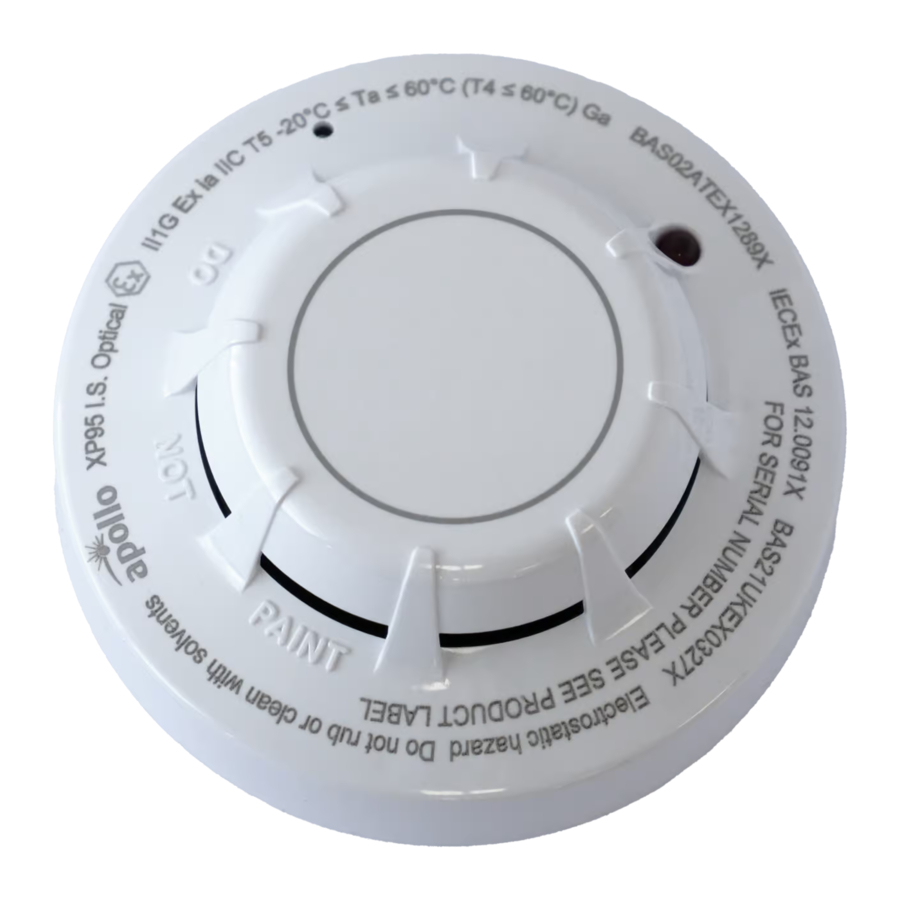
Apollo Orbis, Orbis IS, XP95 IS, XP95 IS MCP Manual
- Installation manual (2 pages)
Advertisement

General
All Apollo IS devices are intended for use in hazardous area systems complying with the European ATEX directive 2014/34/EU that deals with products used in hazardous areas. All such systems must incorporate a certified safety barrier or interface to limit the voltage and power to the circuit. Information on suitable barriers and interfaces can be obtained from Apollo.
These notes are intended to supplement the mandatory requirements of the ATEX directive or other applicable regulations They should not be taken as full instructions for the design and installation of intrinsically safe systems. These activities must be carried out only by qualified personnel.
Certification
The XP95 IS range of detectors and manual call points (MCPs) and the Orbis IS range of detectors are BASEEFA certified as components. Their component certification allows them to be used in certified intrinsically safe systems.
Each product range is covered by a system certificate issued by BASEEFA in Apollo's name. Systems installed according to Apollo system drawings will be covered by the system certification. The use of barriers, interfaces, or other components not included in the system drawing will invalidate the certification.
The system certificate number must be marked on the installed system, preferably on the barrier or interface housing. The system is certified to ATEX only.
Explosion Protection Category
All Apollo XP95 IS detectors and call points comply with the categories:
II IG Ex ia IIC T5 -20°C≤Ta≤45°C (T4≤60°C) Ga
Orbis IS detector categories are:
II IG Ex ia IIC T5 -50°C≤Ta≤40°C (T4≤60°C) Ga
The ATEX EC type examination certificate numbers applicable to Apollo IS devices are given in the table below:
| ATEX Certificate | Apollo Product |
| BAS02ATEX 1289X | XP95 IS Detectors |
| BAS02ATEX 1290X | XP95 IS Call Points |
| Baseefa 06 ATEX 0007X | Orbis Detectors |
| IECEx Certificate | |
| IECEx BAS 12.0091X | XP95 IS Detectors |
| IECEx BAS 12.0091X | XP95 IS Call Points |
| IECEx BAS 06.0002X | Orbis Detectors |
Copies of all component and system certificates, and system drawings are available from Apollo on request.
Installation of Detectors
Detectors must be fitted to certified IS bases. Use of any other bases will invalidate the detector certification. Orbis detectors may be fitted to Series 60 systems using an Orbis IS base adaptor.
The bases must be installed in such a way that all wiring is protected to at least IP20. This requirement will be met if bases are flush mounted. If bases are mounted on BESA boxes, or other boxes having a diameter less than 85mm, they should be fitted with XP95 backplates (Apollo part number 45681-233).
Remote LED indicators may be fitted to Orbis or to XP95 detectors. The LEDs need not be certified but should be either 3mm or 5mm in diameter. The LED terminations must be protected to at least IP20 and the circuits must be segregated from other circuits.
Special Conditions for Safe Use
To avoid problems with electrostatic charging of the enclosure, the equipment must not be located in a dust-laden airflow or cleaned with a dry cloth or with solvents.
Installation of Manual Call Points
Manual call points must be installed to comply with the requirements of the ATEX directive or another applicable code of regulations. All unused cable entry ports must be sealed using suitable stopping plugs to give the required level of ingress protection.
Dust Cover
To ensure optimal performance, leave the dust cover on the product and remove on commissioning.
Further Information
For further information see Apollo publications PP1095 for the XP95 ranges respectively.
For information on Orbis see publication PP2250
See also www.apollo-fire.co.uk/resources/ATEX
Tel: +44 (0) 23 9249 2412
Fax: +44 (0) 23 9249 2754
Email: techsales@apollo-fire.co.uk
Website: www.apollo-fire.co.uk
Documents / Resources
References
Download manual
Here you can download full pdf version of manual, it may contain additional safety instructions, warranty information, FCC rules, etc.
Download Apollo Orbis, Orbis IS, XP95 IS, XP95 IS MCP Manual
Advertisement














Need help?
Do you have a question about the Orbis and is the answer not in the manual?
Questions and answers